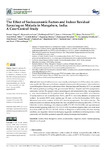2021-11-12Zeitschriftenartikel
The Effect of Socioeconomic Factors and Indoor Residual Spraying on Malaria in Mangaluru, India: A Case-Control Study
Siegert, Konrad
van Loon, Welmoed
Gai, Prabhanjan P.
Rohmann, Jessica L.
Piccininni, Marco
Näher, Anatol-Fiete
Boloor, Archith
Shenoy, Damodara
Mahabala, Chakrapani
Kulkarni, Suyamindra S.
Kumar, Arun
Wedam, Jacob
Gai, Pramod
Devi, Rajeshwari
Jain, Animesh
Kurth, Tobias
Mockenhaupt, Frank P.
India faces 0.5 million malaria cases annually, including half of all Plasmodium vivax malaria
cases worldwide. This case–control study assessed socioeconomic determinants of urban malaria in
coastal Mangaluru, Karnataka, southwestern India. Between June and December 2015, we recruited
859 malaria patients presenting at the governmental Wenlock Hospital and 2190 asymptomatic
community controls. We assessed clinical, parasitological, and socioeconomic data. Among patients,
p. vivax mono-infection (70.1%) predominated. Most patients were male (93%), adult (median,
27 years), had no or low-level education (70.3%), and 57.1% were daily labourers or construction
workers. In controls (59.3% male; median age, 32 years; no/low-level education, 54.5%; daily
labourers/construction workers, 41.3%), 4.1% showed asymptomatic Plasmodium infection. The
odds of malaria was reduced among those who had completed 10th school grade (aOR, 0.3; 95% CI,
0.26–0.42), lived in a building with a tiled roof (aOR, 0.71; 95% CI, 0.53–0.95), and reported recent
indoor residual spraying (aOR, 0.02; 95% CI, 0.01–0.04). In contrast, migrant status was a risk factor
for malaria (aOR, 2.43; 95% CI, 1.60–3.67). Malaria in Mangaluru is influenced by education, housing
condition, and migration. Indoor residual spraying greatly contributes to reducing malaria in this
community and should be promoted, especially among its marginalised members.
Files in this item

